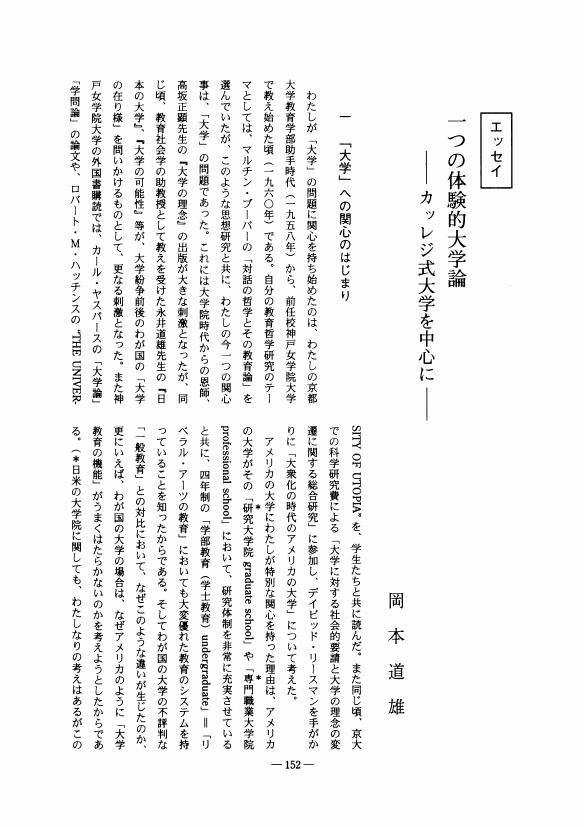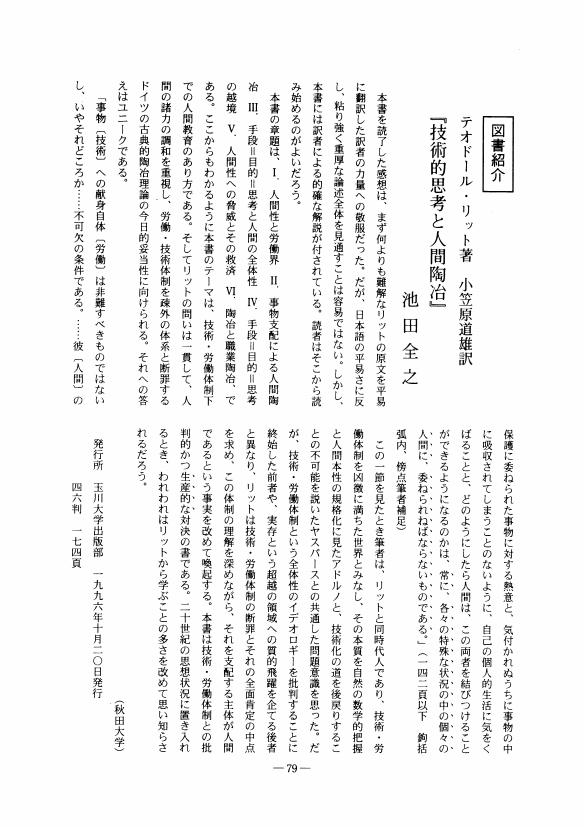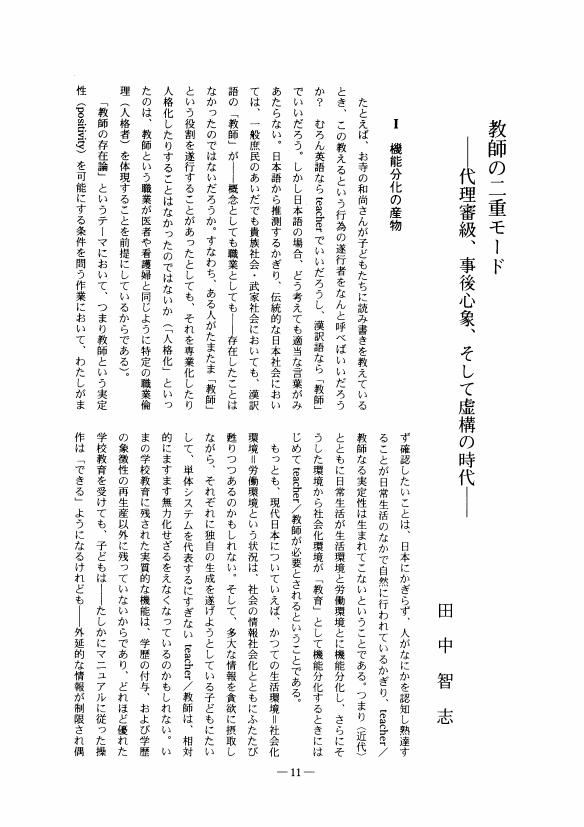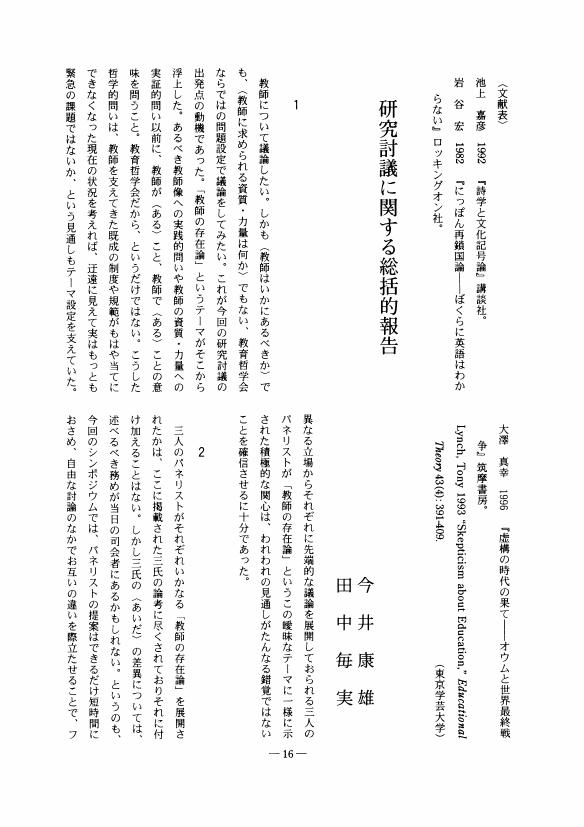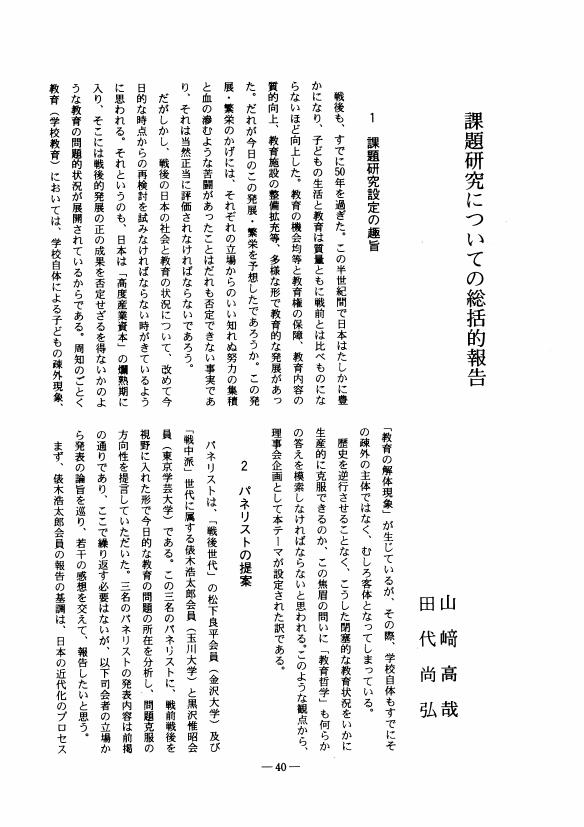1 0 0 0 OA 一つの体験的大学論 カッレジ式大学を中心に
- 著者
- 岡本 道雄
- 出版者
- 教育哲学会
- 雑誌
- 教育哲学研究 (ISSN:03873153)
- 巻号頁・発行日
- vol.1997, no.76, pp.152-164, 1997-11-10 (Released:2009-09-04)
1 0 0 0 OA G・オットーの初期著作における自己探求的な芸術教育学理論の基礎づけについての一考察
- 著者
- 鈴木 幹雄
- 出版者
- 教育哲学会
- 雑誌
- 教育哲学研究 (ISSN:03873153)
- 巻号頁・発行日
- vol.1997, no.76, pp.110-123, 1997-11-10 (Released:2009-09-04)
- 参考文献数
- 48
After the Second World War, German padagogues in art education have been obliged to reflect critically on the theories of art education in the 1920s. Confronting new social and educational situations in Germany, they had to keep in mind several new factors such as expression as beings in the world, contemporaneity, adolescence, contact with modern culture and society, and researches by younger generations. G. Otto re-examined the traditional views of art education from the late 1950s through the early 1960s when the reconstruction after the war terminated. He thought that art education should be planned in a social context and struggled hard to build a new theory of art education suited to the time. As the first step, Otto studied pedagogical anthropology, the adolescence and plastic art theories of the 1920s. In this process, he obtained from anthropology the idea that human beings were members of society. From the theories of plastic art, Otto learned that a human being can discover his relationship to the world by the act of production-expression using materials-subjects. These notions were not emphasized in the views of art education from the time of the >new education< plans. The major views which Otto discovered in his early works are as follows : - “One can develop his ability only by keeping in contact with the world.” -Adolescence is the time when one should come into “contact with compounds made up of culture and society of the times.” - “The treatment, study and experiment of materials correspond to the styles of young people's attitudes.” Since 1963 Otto tried to integrate these views into his concept of art education. In that process, he identified the following as the fundamental points of view for integration : - “Struggles with the selected materials are a step of artistic activities for young generations.” - “One opens up the real world on the basis of his categorical views and experiences obtained by himself.” (W. Klafki) In the process of research for the realization of Kunstpädagogik, Otto tried to integrate these two fundamental points of view into one >kunstpädagogische Theorie< on the basis of the heritages of modern didactic theories which were available in the 1950s. One of these was the theory of >kategoriale Bildung< by Klafki, and another was the didactic theory of structural analysis by P. Heimann who asserted that “the process of teaching should be structured as a whole [in order to get a free analytical point of view for education (teaching act)].”
1 0 0 0 OA ペスタロッチー教育論における「学校」の位置 後期著作を中心として
- 著者
- 大澤 裕
- 出版者
- 教育哲学会
- 雑誌
- 教育哲学研究 (ISSN:03873153)
- 巻号頁・発行日
- vol.1997, no.76, pp.1-14, 1997-11-10 (Released:2009-09-04)
- 参考文献数
- 48
Pestalozzi's pädagogischer Gedanke tiber die Rolle der “Schule” schwankt zwischen seinen fruhen und späten Werken. Zweck dieser Arbeit ist es, die Stelle der Schule in seiner späten Werken zu betrachten. In dieser Abhandlung sollen die drei folgenden Gesichtspunkte behandelt werden; (1) die Schule, die die Funktion der gemeinschaftlichen Erziehung hat, (2) die Einschrankungen des Hauses und die eigene Rolle der Schule, (3) Veredelung und die Schule. Endlich ist sein später Gedanke über Schule folgendermaSen zusammengefaBt. Nach seiner Einsicht, (1) ist die Schulerziehung der die Schuler zu derjenigen Berufstechnik und Wissenschaft fuhrende Anfang, den das Haus ihnen nicht geben kann. (2) Die Schule funktioniert als das Organ, das die im Haus gewonnenen Kenntnisse erweitert, und (3) als das Organ, das den Schillern die im Haus gewonnenen Erlebnisse verallgemeinert, und (4) als der geschützte Ort, wo viele andere Menschen miteinander menschlich leben, und (5) als der Raum, wo sie zukünftige soziale Normen erleben. Und die Schule hat die Funktion, durch die Individuen ihre Lebensweise zu steigern wodurch sie für die Gesellschaft nützliche Menschen werden können. Nach Pestalozzi's Gedanken kann die Schule, wenn sie nicht als eine beschrankte Erziehungskraft sich erkennt, nicht geniigend funktionieren, und nicht nur das, sondern auch sie wirkt als Organ, das sekundäre negative Kräfte hat.
1 0 0 0 OA テオドール・リット著小笠原道雄訳『技術的思考と人間陶冶』
- 著者
- 池田 全之
- 出版者
- 教育哲学会
- 雑誌
- 教育哲学研究 (ISSN:03873153)
- 巻号頁・発行日
- vol.1997, no.75, pp.79, 1997-05-10 (Released:2009-09-04)
1 0 0 0 OA 土橋 寶著『ゲーテ教育学研究-その世界観・遊戯観・人間形成観-』
- 著者
- 西村 拓生
- 出版者
- 教育哲学会
- 雑誌
- 教育哲学研究 (ISSN:03873153)
- 巻号頁・発行日
- vol.1997, no.75, pp.72-78, 1997-05-10 (Released:2009-09-04)
1 0 0 0 OA 村田 昇著『シュプランガー教育学の研究』
- 著者
- 今井 重孝
- 出版者
- 教育哲学会
- 雑誌
- 教育哲学研究 (ISSN:03873153)
- 巻号頁・発行日
- vol.1997, no.75, pp.80, 1997-05-10 (Released:2009-09-04)
1 0 0 0 OA 日本ペスタロッチー・フレーベル学会編『ペスタロッチー・フレーベル事典』
- 著者
- 宮寺 晃夫
- 出版者
- 教育哲学会
- 雑誌
- 教育哲学研究 (ISSN:03873153)
- 巻号頁・発行日
- vol.1997, no.75, pp.81, 1997-05-10 (Released:2009-09-04)
1 0 0 0 OA キリスト教と教育の接点
- 著者
- 松川 成夫
- 出版者
- 教育哲学会
- 雑誌
- 教育哲学研究 (ISSN:03873153)
- 巻号頁・発行日
- vol.1997, no.75, pp.60-69, 1997-05-10 (Released:2009-09-04)
1 0 0 0 OA ペスタロッチーにおける直観概念 生成発展とその周辺
- 著者
- 伊藤 敏子
- 出版者
- 教育哲学会
- 雑誌
- 教育哲学研究 (ISSN:03873153)
- 巻号頁・発行日
- vol.1997, no.76, pp.15-29, 1997-11-10 (Released:2009-09-04)
- 参考文献数
- 37
Der Begriff der “Anschauung” ist in der Pädagogik Pestalozzis zentral. Dieser Begriff ist in einem doppelten Sinne zweigliedrig. Erstens gliedert er sich nach der äusseren und der inneren Anschauung, zweitens besteht die innere Anschauung wiederum aus der “mich anse-henden” inneren Anschauung und der “Gott ansehenden” inneren Anschauung. Die vor-liegende Arbeit geht dem Entstehungsund dem Verstärkungsprozess dieses Begriffs nach. Das Hauptinteresse gilt den verschiedenen Ideen, von denen der Anschauungsbegriff in ver-schiedenen Phasen seiner Genese beeinflusst wurde. Bezüglich der äusseren Anschauung steht der Einfluss des Sensualismus im Zentrum. Die von Pestalozzi zitierten Bucher belegen, dass er sich in der Entstehungsphase seiner Anschauungslehre mit dem deutschen Sensualismus auseinandersetzte, während er in der Verstärkungsphase der Anschauungslehre den franzasischen Sensualismus bevorzugte. Bezüglich der inneren Anschauung wird die Betonung des Gemüts eingehend untersucht. Obgleich Pestalozzi zu keiner Zeit seines Lebens konfesionell gebunden war, brachte ihn seine Betonung der Gemiitskrafte immer näher zum religiösen Gedanken, wonach die “Gott an-sehende” innere Anschauung belebt werden soll.
1 0 0 0 OA 教育哲学を考える
- 著者
- 小川 博久
- 出版者
- 教育哲学会
- 雑誌
- 教育哲学研究 (ISSN:03873153)
- 巻号頁・発行日
- vol.1997, no.75, pp.70-71, 1997-05-10 (Released:2009-09-04)
1 0 0 0 OA 教師の二重モード 代理審級、事後心象、そして虚構の時代
- 著者
- 田中 智志
- 出版者
- 教育哲学会
- 雑誌
- 教育哲学研究 (ISSN:03873153)
- 巻号頁・発行日
- vol.1997, no.75, pp.11-16, 1997-05-10 (Released:2009-09-04)
- 参考文献数
- 4
1 0 0 0 OA 技術論から相互関係論へ-〈教師-生徒〉関係の組みかえ-
- 著者
- 高橋 勝
- 出版者
- 教育哲学会
- 雑誌
- 教育哲学研究 (ISSN:03873153)
- 巻号頁・発行日
- vol.1997, no.75, pp.5-10, 1997-05-10 (Released:2010-05-07)
- 参考文献数
- 12
1 0 0 0 OA 研究討議に関する総括的報告
- 著者
- 今井 康雄 田中 毎実
- 出版者
- 教育哲学会
- 雑誌
- 教育哲学研究 (ISSN:03873153)
- 巻号頁・発行日
- vol.1997, no.75, pp.16-22, 1997-05-10 (Released:2009-09-04)
1 0 0 0 OA ジルーの批判的教育学に関する一考察-「差異」と公共領域-
- 著者
- 上地 完治
- 出版者
- 教育哲学会
- 雑誌
- 教育哲学研究 (ISSN:03873153)
- 巻号頁・発行日
- vol.1997, no.75, pp.47-59, 1997-05-10 (Released:2009-09-04)
- 参考文献数
- 39
This paper analyzes the concept of “difference” in Giroux's critical pedagogy and, via the author's preliminary hypothesis, inquires into the relationship of “difference” and social emancipation.During the 1990s Giroux has emphasized “difference”, especially what the author refers to as the complexity of “difference.” However, in light of Giroux's theory for comprehensive social emancipation, the concept of “difference” simultaneously produces some problematic relationships. The theory of emancipation which is based on only one “difference”, cannot be applied to another “difference” because “difference” exists in plural categories. Moreover, categorizing many kinds of “difference” leads to specific and isolated theories.The solution which Giroux finds for this question in his critical pedagogy refers to the public sphere. Giroux's idea of the public sphere is radically democratic and in that sphere one is able not only to guarantee diverse discourses based on “difference”, but also lead to social emancipation. Also in that sphere one needs transformative intellectuals who articulate the idea of “difference” with reference to emancipation.
1 0 0 0 OA 戦後教育の哲学的基底 自己矛盾としての〈子ども尊重〉の思想の “乱熟”
- 著者
- 松下 良平
- 出版者
- 教育哲学会
- 雑誌
- 教育哲学研究 (ISSN:03873153)
- 巻号頁・発行日
- vol.1997, no.75, pp.28-33, 1997-05-10 (Released:2010-05-07)
- 参考文献数
- 3
1 0 0 0 OA 戦後教育を問う ポストモダンの視界から
- 著者
- 黒沢 惟昭
- 出版者
- 教育哲学会
- 雑誌
- 教育哲学研究 (ISSN:03873153)
- 巻号頁・発行日
- vol.1997, no.75, pp.34-39, 1997-05-10 (Released:2009-09-04)
1 0 0 0 OA 課題研究についての総括的報告
- 著者
- 山崎 高哉 田代 尚弘
- 出版者
- 教育哲学会
- 雑誌
- 教育哲学研究 (ISSN:03873153)
- 巻号頁・発行日
- vol.1997, no.75, pp.40-46, 1997-05-10 (Released:2010-01-22)
1 0 0 0 OA 市村尚久・天野正治・増淵幸男編『教育関係の再構築』
- 著者
- 立川 明
- 出版者
- 教育哲学会
- 雑誌
- 教育哲学研究 (ISSN:03873153)
- 巻号頁・発行日
- vol.1996, no.74, pp.64, 1996-11-10 (Released:2009-09-04)
1 0 0 0 OA 「中間者」としての教師-教職への存在論的接近
- 著者
- 佐藤 学
- 出版者
- 教育哲学会
- 雑誌
- 教育哲学研究 (ISSN:03873153)
- 巻号頁・発行日
- vol.1997, no.75, pp.1-5, 1997-05-10 (Released:2009-09-04)
- 参考文献数
- 6
1 0 0 0 OA 岡田渥美著『人間形成論-教育学の再構築のために』
- 著者
- 沼田 裕之
- 出版者
- 教育哲学会
- 雑誌
- 教育哲学研究 (ISSN:03873153)
- 巻号頁・発行日
- vol.1996, no.74, pp.62, 1996-11-10 (Released:2009-09-04)
